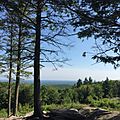Mount Agamenticus facts for kids
Mount Agamenticus is a 692-foot-high hill in York, Maine. It's like a lonely mountain standing tall in a mostly flat area. People sometimes call it "Big A." This name came from a ski slope that used to be on its side.
The land around Mount Agamenticus covers almost 30,000 acres. This huge area spreads across towns like Eliot, Ogunquit, South Berwick, Wells, and York. The top of the mountain is a special park. It's a home for many wild animals and a great place for outdoor activities.
Even though it's only 692 feet above the ocean, you can see very far from its peak on a clear day. You might spot tall buildings in Boston to the south. To the north, you can see Cape Elizabeth and the entrance to Casco Bay. Looking west, you can see the Presidential Range, including Mount Washington. Out at sea, the Isles of Shoals and Boon Island are also easy to spot.
At the mountain's peak, there's a special burial place. It's said to be where Mi'kmaq Chief St. Aspinquid was laid to rest.
Contents
Exploring Mount Agamenticus's Past
Early Maps and Names
In 1614, Captain John Smith explored the Gulf of Maine. He made detailed maps of this new land. When he returned to London, he showed his maps to Prince Charles. Smith asked the Prince to give English names to the places.
Prince Charles agreed. In 1616, a map was published with Smith's book, A Description of New England. On this map, the mountain's Native American name, "Sassanows," was changed to "Snadoun Hill." However, many of the Prince's new names didn't stick. The mountain eventually took the name of the nearby settlement, "Plantation of Agamenticus." This name came from the Abenaki name for the York River.
The Legend of St. Aspinquid
St. Aspinquid was a Mi'kmaq chief. Legend says he was murdered in 1696. He was then declared a martyr and buried on top of Mount Agamenticus.
The story says Saint Aspinquid was born in 1588. He became a Christian and shared his faith with many tribes. His funeral was said to be a huge event. Hundreds, even thousands, of Native Americans supposedly attended.
Some people have wondered if St. Aspinquid was a real person. They think the story might be a made-up version of a real chief named Passaconaway. A writer named Sarah Orne Jewett once said she couldn't find any old stories about him. She only found the legend in a local newspaper.
Today, a symbolic pile of stones, called a cairn, stands on the summit. It is a memorial to the legend of Aspinquid.
Trails and Views
Mount Agamenticus is a great place for hiking. There's a road that goes to the top, and some parking spots there. At the base of the mountain, there's a main parking area. From there, a short trail leads to the "ring trail." This trail goes around the mountain's summit. Other trails branch off the ring trail, giving you different ways to reach the top.
From the summit, you can see for miles. It's also a fantastic spot for watching hawks fly in New England. A large cell phone tower stands at the top today, along with other antennas.
Images for kids



